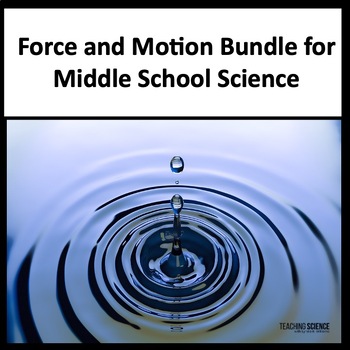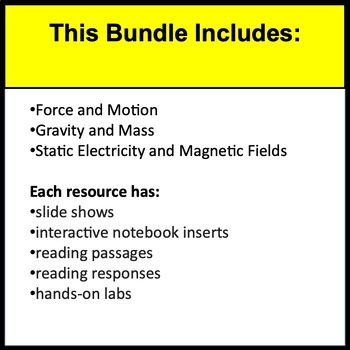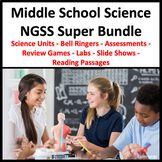Force and Motion Middle School Science Lessons and Activities and Labs
- Zip
Products in this Bundle (3)
Also included in
- This Bundle for Utah SEEd 7th grade includes science resources for each strand and standard. Each unit included addresses specific Utah SEEd standards for 7th grade. Students will love these engaging activities for Utah SEEd 7th Grade. You will love saving time by having someone creating resources wPrice $128.76Original Price $160.95Save $32.19
- Do you want to save time in planning for middle school science? This Middle School Science Curriculum Bundle addresses all the DCIs for Middle School NGSS. Complete units with phenomena-based 5E Science Lessons for 6th, 7th, and 8th Grade.Save more than 30% by purchasing this bundle! ❤️ Get back toPrice $304.32Original Price $434.75Save $130.43
- This is a bundle for 8th Grade: NGSS California Integrated Model. This bundle covers the PEs and standards for NGSS for 8th grade in California. Purchase of this 8th-grade science bundle will save you 20% on these resources. If you teach 8th grade science in California, you need this bundle!ResourcePrice $146.56Original Price $183.20Save $36.64
- Do you teach 8th Grade Science in South Carolina? This science bundle is just what you need. This South Carolina eighth-grade bundle covers all the science standards for SC Ready 8th grade. It is a full-year bundle, and you save 20% on these resources by purchasing in the bundle! From the South CaroPrice $107.20Original Price $134.65Save $27.45
- This bundle is for Indiana Science Standards 7th Grade. It covers all the standards for 7th-grade science in Indiana. This is a full-year bundle for the Indiana Science Standards for 7th grade. This bundle covers all the 7th-grade standards and gives your science activities for the year! Aligns withPrice $133.60Original Price $167.20Save $33.60
- This NGSS Middle School Science Bundle is my biggest bundle! It includes all my middle school science units, Bell Ringers, Jeopardy-style games, Assessments, and Informational Text Science Units for Middle School. It addresses all the NGSS standards for 6th, 7th, and 8th Grade NGSS science. Save whePrice $489.55Original Price $699.35Save $209.80
Description
Students will love learning about force and interactions in this middle school science bundle. Students will be engaged in fun hands-on labs on forces and their interactions and engaging STEM activities. This bundle covers all the standards for Forces and Their Interactions DCI for Middle School Science. Save 20% by purchasing this bundle!
This Bundle Includes:
Each resource has:
- slide shows
- interactive notebook inserts
- reading passages
- reading responses
- hands-on labs
This bundle includes:
1, Gravity and Mass Unit for Middle School: Students will learn that gravity is a force that attracts, it and is influenced by the mass and distance of interacting objects. Students will construct arguments based on evidence to support the claim that gravitational interactions are attractive and depend on the masses of interacting objects in the MS NGSS and Utah SEEd 7th Grade resource.
This resource aligns with NGSS Middle School Standard
MS-PS2-4.
Construct and present arguments using evidence to support the claim that gravitational interactions are attractive and depend on the masses of interacting objects.
And also Utah SEEd
Standard 7.1.5
Engaging in argument from evidence to support the claim that gravitational interactions within a system are attractive and dependent upon the masses of interacting objects.
The unit begins with a slide show on Gravity. Students take notes in a strategic note-taking guide. This unit goes on to have graphing activities, an article to read, QR code research, and making arguments from evidence gathered. This unit includes word wall words to enhance instruction.
2. Static Electricity and Magnetic Fields: Students will love these labs on static electricity and magnetism! Both magnetic fields and static electric fields will be examined. We cannot see these fields, but we can see the forces they exert on each other even when objects are not touching. This is a huge resource addressing several standards. There are 98 pages in this unit on static electricity for Middle School.
Students will learn about energy fields by studying these two topics (static electricity and magnetism) and will be able to demonstrate a field through a hands-on activity.
Students will also use engineering skills to create an electromagnet and then they will test it using Fair Test practices to see if they can influence the strength or their electromagnet.
There is a slide show on static electricity that will give background information on the atomic structure and the interaction of electrons in simple terms that middle school science students can understand.
This resource includes six labs in the 5 E format. It also includes follow up pages for each lab.
A three-page article on magnetism is included with comprehension questions. Students will practice reading informational text skills aligned with CCSS. Word Wall Words are included.
Students will also make a model of electrons moving to create charge imbalance and of static discharge. This aligns with MS PS1-1 and will help students make a model that shows the electrons and protons of several molecules.
This resource is aligned with NGSS Motion and Stability: Forces and Interactions
NGSS MS-PS2-5. Conduct an investigation and evaluate the experimental design to provide evidence that fields exist between objects exerting forces on each other even though the objects are not in contact.
MS-PS2-3. Ask questions about data to determine the factors that affect the strength of electric and magnetic forces. [Clarification Statement: Examples of devices that use electric and magnetic forces could include electromagnets, electric motors, or generators.
MS PS1-1
Develop models to describe the atomic composition of simple molecules and extended structures (partially addressed in this resource).
Also aligned with Utah SEEd 7th grade
Standard 7.1.3
Construct a model using observational evidence to describe the nature of fields that exist between objects that exert forces on each other even though the objects are not in contact. Emphasize the cause and effect relationship between properties of objects (such as magnets or electrically charged objects) and the forces they exert.
Standard 7.1.4
Collect and analyze data to determine the factors that affect the strength of electric and magnetic forces. Examples could include electromagnets, electric motors, or generators. Examples of data could include the effect of the number of turns of wire on the strength of an electromagnet, or of increasing the number or strength of magnets on the speed of an electric motor.
3. Force and Motion Middle School Students will love learning that a change in an object's motion depends on the mass of the object and the combined forces. Students will learn about colliding objects and the impact of a collision through investigation. This is a complete unit for middle school NGSS, Force, and Motion. Students will love learning about force and motion through these great labs, like making a balloon car that is air-powered! They will learn about changing an object's motion by forces acting upon it and they will apply Newton's third law of motion in a problem involving the motion of two colliding objects. They will learn about fair tests and variables and they will plan an investigation.
This resource includes an article on Newton and follow-up pages to review Newton’s three laws of motion. It includes a nonfiction article on Energy and Force with comprehension questions and follow-up pages. It includes 4 labs on Force and Motion, each has the 5 E lesson plan and follow-up pages. The labs are easy to use with simple inexpensive materials.
Students will watch a slideshow on Fair Tests and learn about independent and dependent variables. There is a follow-up page for this as well.
This resource includes informational text passages, response pages, interactive notebook flaps, 5 E lesson plans, Labs, a CLOSE reading activity, worksheets, and an assessment. This HUGE unit has over 90 pages or slides.
Students will finish the unit with a multiple choice quiz as an assessment. This quiz is at the end of the year format. The quiz and follow-up pages all have answer keys.
NGSS MS-PS2-1. Apply Newton’s Third Law to design a solution to a problem involving the motion of two colliding objects.* [Clarification Statement: Examples of practical problems could include the impact of collisions between two cars, between a car and stationary objects, and between a meteor and a space vehicle.
NGSS MS-PS2-2. Plan an investigation to provide evidence that the change in an object’s motion depends on the sum of the forces on the object and the mass of the object.
It is also aligned with Utah SEEd for 7th grade.
Utah SEEd
Standard 7.1.1
Carry out an investigation that provides evidence that a change in an object's motion is dependent on the mass of the object and the sum of the forces acting on it.
Standard 7.1.2
Apply Newton's Third Law to design a solution to a problem involving the motion of two colliding objects in a system. Examples could include collisions between two moving objects or between a moving object and a stationary object.
Standard 7.1.5
Engage in argument from evidence to support the claim that gravitational interactions within a system are attractive and dependent upon the masses of interacting objects. Examples of evidence for arguments could include mathematical data generated from various simulations. (PS2.B)
Please email me if you have questions about my products lywilliams1@gmail.com
Do you teach about cell structure and function? Do you teach the biological evolution strand?
This bundle addresses all the Forces and Interactions Strand for Middle school Science:
MS PS2-1
MS PS2-2
MS PS2-3
MS PS2-4
MS PS2-5
and
Utah SEEd 7.1.1
Utah SEEd 7.1.2
Utah SEEd 7.1.3
Utah SEEd 7.1.4
Utah SEEd 7.1.5
These resources are created by Lynda R. Williams at Teaching Science
Follow me and get news of my new resources. Each new resource is discounted by 50% for the first 24 hours!
Please see other resources for NGSS and Utah SEEd middle school:
Evolution Bundle for NGSS Middle School and Utah SEEd 7th Grade
Coral Reef CLOSE Reading Science Literacy Unit











